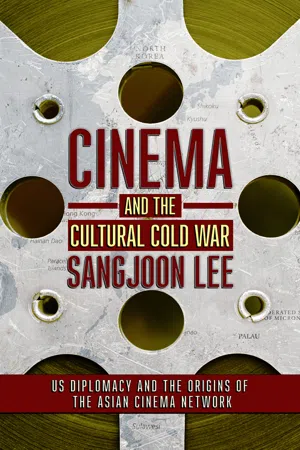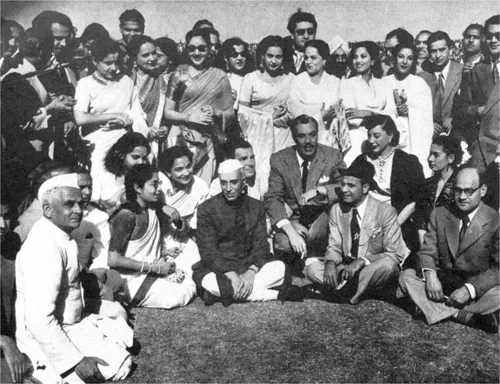Chapter 1
The Asia Foundation’s Motion Picture Project
On December 17, 1953, Charles M. Tanner, the Hollywood liaison of the Asia Foundation (TAF), a San Francisco-based philanthropic organization, was having lunch with two Hollywood magnates: Frank Capra, a celebrated Hollywood director-producer, and Luigi Luraschi, the head of foreign and domestic censorship at Paramount Studios. Before this meeting, Tanner had convened with Hollywood heavyweights such as Cecil B. DeMille, Herbert J. Yates, and a group of first-tier Hollywood scriptwriters, including Winston Miller, Leonard Spigelgass, Allen Rivkin, and Morris Ryskind.1 Carleton W. Alsop, an ex-CIA agent, acted as mediator.2 The meeting had been arranged by Luraschi’s office at Paramount.3
The Asia Foundation, formerly known as the Committee for a Free Asia, was a private non-profit organization incorporated under the laws of the state of California in 1951.4 Its primary aim, according to its mission statement, was to make “a significant contribution to development in Asia and to Asian-American understanding and friendship.”5 Tanner, a former United States Information Service (USIS) motion picture officer, was working at TAF’s headquarters in San Francisco. This was his second mission to Hollywood since he had been hired in May 1953. This time, TAF head office had given him the task of consulting with some of the American film industry’s most powerful, gifted, and ideologically “appropriate” personnel to discover whether Hollywood was willing to support the TAF’s newly launched project in the Asian motion picture industry. Tanner had a particular subject in mind: the Southeast Asian Film Festival, scheduled to be held in Tokyo in May 1954. The Southeast Asian Film Festival was an annual event of the Federation of Motion Picture Producers in Southeast Asia (FPA), a pan-Asian organization recently established by the Japanese film executive Nagata Masaichi, president of Daiei Studio in Japan. While meeting with Capra and Luraschi, Tanner asked them to help sponsor the Southeast Asian Film Festival by convincing the Motion Picture Association of America (MPAA) to donate the festival’s first prize, a 35 mm Mitchell movie camera. In fact, TAF had already purchased the camera and was ready to ship it to Tokyo; apparently it was looking only for the MPAA’s illustrious label.6 Tanner also asked that some of the industry’s celebrities be present at the festival as Hollywood representatives. Capra and DeMille were undoubtedly Tanner’s top choices. Their fervent anticommunism has been well documented.7
As a film consultant to the recently created USIS and one of the founding members of the National Committee for a Free Europe, DeMille was a Cold War conservative who, according to Nora Sayre, firmly believed there was “a Red band encircling the earth.”8 Less than two years earlier, Greatest Show on Earth (1951), one of DeMille’s signature extravaganza films, had been shown at the International Film Festival of India (IFFI), held in Bombay from January 24 to February 1, 1952.9 Four other American entries, An American in Paris (Vincent Minnelli, 1951), Alice in Wonderland (Clyde Geronimi, Wilfred Jackson, and Hamilton Luske, 1951), Bright Victory (Mark Robson, 1951), and Jean Renoir’s France-India-America coproduction The River (1951), had also been introduced to Indian audiences during the festival.10 IFFI was the first international film festival held anywhere in Asia. It showed about fifty feature films and seventy-five documentaries from twenty-three countries, including Italy, Japan, China, the UK, France, the USSR, and the United States.11 Other notable films screened at the festival were Bicycle Thieves (Ladri di biciclette, Vittorio De Sica, Italy, 1948), Miracle in Milan (Miracolo a Milano, Vittorio De Sica, Italy, 1951), Rome, Open City (Roma città aperta, Roberto Rossellini, Italy, 1945), Orpheus (Orphée, Jean Cocteau, France, 1950), The Trap (Past, Martin Fricˇ, Czechoslovakia, 1950), Yukiwarisoo (Minoru Matsui, Japan, 1939), The White Haired Girl (Bai Mao Nu, Wang Bin and Shui Hua, China, 1950), The Dancing Fleece (Frederick Wilson, UK, 1950), Mussorgsky (Musorgskiy, Griogri Roshal, USSR, 1950), and The Fall of Berlin (Padeniye Berlina, Mikheil Chiaureli, USSR, 1950).12 K. L. Khandpur, senior director of the film division in India, characterized this event as historic, claiming that “it was … the first time that the Indian film industry was exposed to such a vast range of outstanding films of [the] postwar era.”13 Kishore Valicha argues that this “exposure” resulted in a “more serious and, in artistic terms, a more articulate kind of Indian film,” such as Bimal Roy’s Do Bigha Zamin (1953) and Devdas (1955) and Guru Dutt’s Kaagaz Ke Phool (1959).14
At IFFI, Frank Capra, known as a “fighter against communism,” represented the US film industry.15 He gave talks on technique, organization, and story value during the festival.16 At the time, Capra was a member of the President’s Advisory Committee, which advised the State Department on how best to present the United States’ image in the information media, including radio, television, and motion pictures. Capra saw the Cold War as “a death struggle between the free world and the slave world … a battle for the minds of men.”17 Chester Bowles, the US ambassador to India and Nepal, had solicited Capra to attend IFFI to help gauge the level of Soviet and Chinese influence on India. Besides Capra, Ingrid Bergman and Gene Tierney had been invited, but at the last moment, they could not attend. Hence, it was Capra, Kenneth McEldowney (producer of The River), Harry Stone (an MPAA officer), and Floyde E. Brooker (audio visual chief of the Mutual Security Agency) who attended in their place as the American film industry representatives.18 As Nitin Govil argues, Capra’s attendance at the festival was “one of many coordinated displays of geopolitical friendship between the United States and India.”19 It also, however, suggests a new perspective on US cultural diplomacy in Asia at the height of the Cold War. Surprisingly, Capra was under scrutiny by the House Un-American Activities Committee (HUAC), having been blacklisted under suspicion of being a communist or communist sympathizer.20 Just before IFFI, he was cleared of all charges.
Figure 1.1 The first International Film Festival of India (IFFI) was held in 1952, and American director Frank Capra (a man wearing a gray hat in the front row) attended as a part of the US delegation. The IFFI was inaugurated by the Indian prime minister, Jawaharlal Nehru (middle of the front row), on January 24, 1952. March of India 4, no. 4 (March–April 1952): 5.
For Capra, consequently, attending IFFI was a chance to display acts of patriotism that would prove his strong anticommunism. This was Capra’s chance to go back to Hollywood. Capra noticed the presence of “commies” at the festival.21 In his autobiography, he wrote, “I warned Festival officials I was not here to be sucked into any Commie plots. I was here to beat their brains out if I could and for no other reason.”22 Capra wrote afterward to DeMille, “The Russians have a large delegation of some 15 people here, and the Chinese about ten. Also there are delegates from Hungary and Czechoslovakia…. We need all the help we can get to hold our own here on their battleground.”23 Capra was likewise enthusiastic about the trip to Japan. He even suggested that “not one man should go but a team” to increase Hollywood’s influence over the Japanese movie industry and to combat communist motion picture activities in Asia.24 All in all, Tanner’s mission to Hollywood promised to be fruitful, and it seemed certain that some of Hollywood’s big names, like Capra and DeMille, would come to Japan to throw their weight behind the FPA.
Nevertheless, TAF’s undertaking in Hollywood raises a number of questions. Nagata Masaichi and other film executives in the region had founded the FPA. Its objective, according to the FPA’s official letter, was to “promote the motion picture industry in the countries of Southeast Asia and to raise the artistic and technical standards of motion pictures and ensure cultural dissemination and interchange of motion pictures in the Far East.”25 Given this objective, what was the logic behind Tanner’s meetings with Hollywood producers, directors, writers, and executives in support of the FPA? For what purpose, likewise, did TAF become involved in the formation of the FPA and its annual film festival? Who was Tanner, and why were the Paramount executive Luraschi and prominent Hollywood directors like Capra and DeMille attached to TAF’s activities? What were the consequences of TAF’s motion picture projects, and how did the film industry in Asia respond?
Although TAF was ostensibly a private, nongovernmental foundation, in reality it was quietly subsidized in large part—perhaps even completely—by the US government and the CIA. Because of this support, it should rather be called a “quasi-nongovernmental organization.”26 TAF’s CIA connection was not publicly acknowledged until 1967, when Ramparts magazine published a special report on the CIA’s funding of various cultural and educational organizations. The New York Times simultaneously published a series of reports revealing the covert CIA sponsorship of “an astonishing variety of other US citizen groups engaged in Cold War propaganda battlefields with communist fronts.”27 The Congress for Cultural Freedom (CCF) was the Times’ primary target, but TAF was also included, although it was considered less controversial than the CCF,.28 Like other nongovernmental philanthropic institutions that operated in the battle for hearts and minds, such as Beacon, Kaplan, Appalachian, and the Borden Trust, TAF was a camouflaged association shaped and carried out by the CIA, following the direction of the US government’s foreign cultural policy. Victor Marchetti, a former CIA employee, alleges that the foundation had the objective of “disseminat[ing] throughout Asia a negative vision of Mainland China, North Vietnam, and North Korea,” and continues, “[The Asia Foundation] sponsored scholarly research, supported conferences and symposia, and ran an academic exchange program, a CIA subsidy that reached 8 million dollars a year.”29
With a view to exploring how US government–led Cold War cultural policies influenced the Asian regional film industry in the 1950s, this chapter investigates how and to what extent TAF and its field agents covertly acted to construct an alliance of anticommunist motion picture producers in Asia. It also scrutinizes the ways TAF agents responded to the various needs of local film executives and negotiated with the constantly changing political, social, and cultural environments in the region during the project’s early activities. Accordingly, this chapter begins with the origin of TAF, the Committee for a Free Asia (CFA).
The Committee for a Free Asia
The CFA was originally a creation of the executive branch, intended to advance US foreign policy interests in Asia. It was established on March 12, 1951, during the second Truman administration (1949–53), “by a group of Californians who believed that a non-governmental American organization primarily focused on Asia could help to increase the desire and ability of Asians to resist Communism on their own soil.”30 The Korean War was then at its height. Besides its headquarters in San Francisco and offices in Washington, DC, and New York City, TAF operated more than fifteen field offices in major cities throughout the 1950s, from Tokyo and Manila to Karachi and Rangoon. The CFA’s initial board of trustees was composed of...

